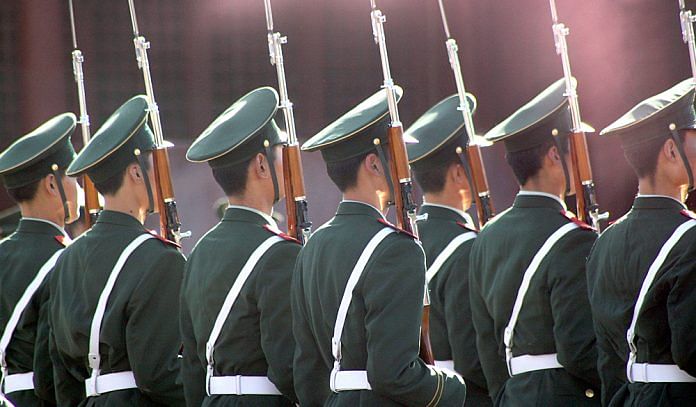A People’s Liberation Army Strategic Support Force contingent made its debut appearance at China’s military day parade, earlier this year. Formed on this day in 2015, it is mandated to create synergies between China’s space, cyber and electronic warfare. The PLA considers these three domains critical for “commanding strategic heights.” The SSF was formed to optimise China’s dominance in these three domains and also contribute to enhancing the PLA’s broader goals of strategic deterrence and integration for information warfare.
Reasons for SSF’s formation
Though the Strategic Support Force (SSF) was formed only in 2015, the conversation in China surrounding information and space warfare had begun in the 1990s. The United States’ use of information technology in the first Gulf War (August 1990-February 1991) sparked debates in the Chinese military establishment and academia. The national humiliation during the Third Taiwan Strait Crisis of 1996 and the bombing of its embassy in Belgrade, Serbia, by the US-led NATO forces in 1999 compelled China to relook at and rework its armed forces.
China drew two lessons from these experiences. First, the integration of information technology could grant military superiority over the adversaries. Second, the US’ use of these technologies created dependencies, which could be exploited during wartime. Practically for China, cyber and information technology were the only domains to counter the asymmetry against the US using critical nodes. The Chinese spent the late 1990s and early 2000s in enhancing their space and cyber capabilities. The big boosts came in the late 2000s when China tested its anti-satellite system and fielded the BeiDou navigation satellite system. By the end of the first decade of the 2000s, China had developed C4ISR capabilities in the region.
The Science of Military Strategy 2013, which is the most important PLA textbook in recent times, demands China’s strategic expansion in space and information domains. The literature also calls for merging of cyber, space and electromagnetic capabilities, which were earlier with different organs of the People’s Liberation Army (PLA) and the Central Military Commission (CMC). China’s 2015 military white paper repeatedly echoed the same lines. The SSF’s creation that year paved the way for integration in these three domains. The most important factor for the SSF’s creation was the desire to consolidate the PLA’s information warfare capabilities under one roof for improving efficiency. The reforms also brought the SSF under the CMC’s direct command, giving President Xi Jinping complete control over it.
Also read: China’s Navy sails beyond its shores while Indian military looks at the budget
Structure, role and mandate
The SSF is headed by Lt General Gao Jin, who was earlier with China’s Second Artillery Corps (now People’s Liberation Army Rocket Force) and the Academy of Military Sciences. The SSF is broadly divided into two parts, the Space Systems Department (SSD) and the Network Systems Department (NSD). While the SSD is responsible for missions in space, the NSD looks after cyber and electromagnetic warfare. There is also literature pointing at the SSF’s psychological warfare, but the information available is sketchy. Prima facie, it appears that the General Staff Department’s 3PLA and 4PLA’s cyber espionage, technical reconnaissance, and electronic warfare duties are handed over to the NSD.
The SSF’s mandate is to collect and harness information from outer space, cyber domain, and electromagnetic system. However, the 2019 military white paper also describes the SSF’s role comprising support for the forces for battlefield environment, information, communications, information security, and new technology testing. Hence, “information support” and “information warfare” could be inferred as the SSF’s main missions. The prior broadly means collecting information, supporting theatre commands with information for joint operations, feeding information for strategic deterrence in space and nuclear domains, and enabling information to services for force development. The latter means conducting information operations like cyber espionage, countering space-cyber-electromagnetic missions, playing supporting roles to paralyse the enemy’s joint operational capabilities, and blinding the enemy’s war command system in the initial stages of the conflict.
Also read: Chinese military white paper suggests a highly conflicted worldview
Future of Chinese information warfare
The PLA SSF completes four years today. It has a key role to play in achieving President Xi Jinping’s dream of making the PLA mechanised by 2020, informative by 2035, and a world-class army by 2050. Currently, it is still a force in transition and faces challenges and pushback like any other modernising force. But in the future of the Chinese military strategy and information warfare, the SSF will certainly play an important role.
Xi’s reforms intended to make the PLA battle-ready in peace and wartime. The SSF’s information and technology support allow the PLA to enhance its strike capabilities, especially against powerful enemies. Cross-domain integration enables the efficient launching of space and cyberattacks against political, economic, and civilian targets as a deterrent. This would be integral to China’s approach to any informatised war in the future.
The author is Research Analyst on China at the Takshashila Institution. He compiles the PLA Insight, a weekly newsletter that covers the Chinese People’s Liberation Army. Views are personal.



